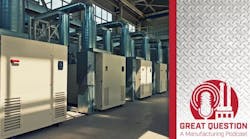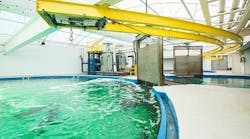Have you ever visited an aquarium and wondered how the animals found their way in there? Engineers at Air Technical Industries learned first-hand by designing a creative solution for the Wildlife Conservation Society (WCS) in New York City: the first continuous, double-rail, serpentine crane system of its kind.
Air Technical Industries (ATI) thrives on customized designs, with a 50-year history built on tackling the projects that others have called “impossible.” They pride themselves on their “Challenge Us” form on their website, which was how WCS found them.
“What ATI put together was exceptional,” raved Stephen Taylor, Principal in Charge at Vakota Architecture, who won a Sport/Entertainment Award of Merit with Dunne and Markis Engineer Consultants for the New York Aquarium Aquatheater by Engineering News-Record in 2013. They faced significant, atypical parameters, like ensuring longevity in the harsh environment of salt water pools with ocean moisture, as well as needing to create a natural, animal-friendly design never before imagined.
The Wildlife Conservation Society’s (WCS) New York Aquarium had also had its share of challenges.
In October 2012, when Hurricane Sandy barreled in, the aquarium shut down and plans for new buildings were delayed. The staff stayed to take care of the animals and to make sure that the generators and temporary power for water filtration systems were back up within days. Thanks to their efforts, all mammals were alive and well after Sandy took her leave and the aquarium was up and running quickly. “The aquarium staff is amazing and resilient,” Taylor remarked.
The buildings, however, did not hold up as well. Due to repairs, what started as a temporary holding building for sharks is still their main habitat. Originally built for sea lions, the building was adapted to house sharks, with a roof to keep the water calm and climate controlled. The lifting equipment needed by the Wildlife Conservation Society had to integrate into a temporary building sitting over an existing building, working with unlikely conditions.










